Effects of Nigella sativa on Performance, Blood Profiles, and Antibody Titer against Newcastle Disease in Broilers
Author details:
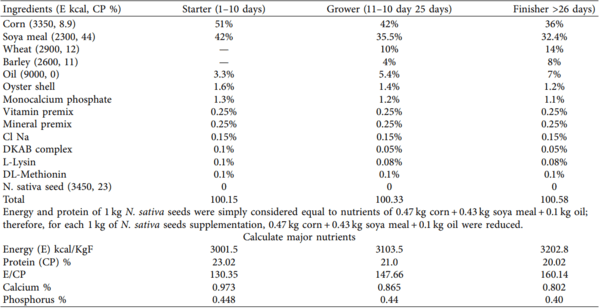
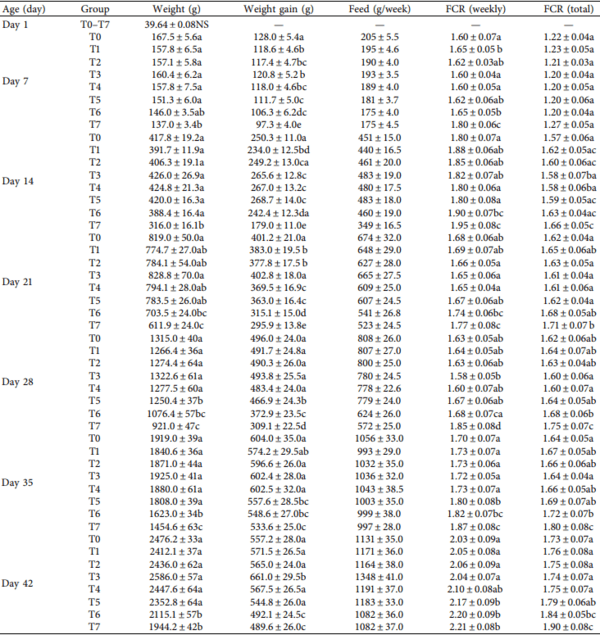

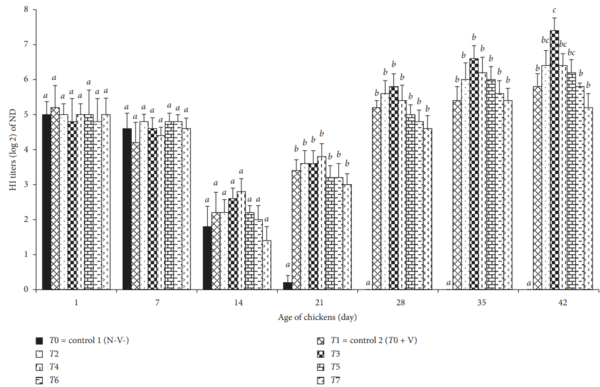
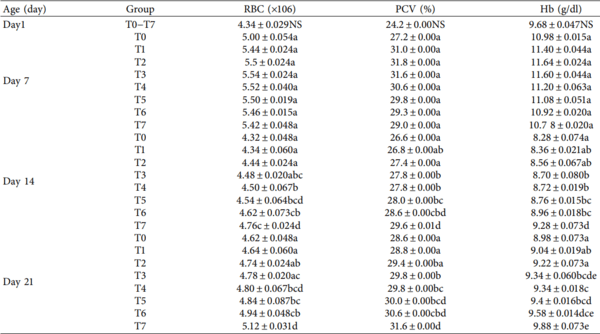

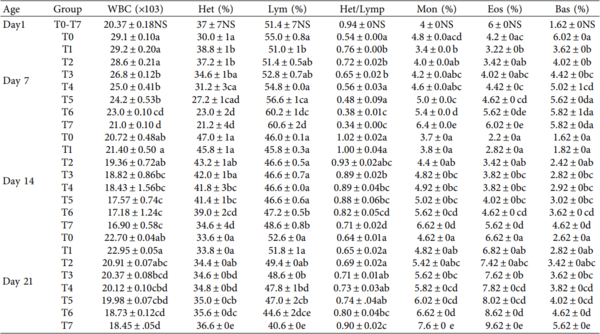
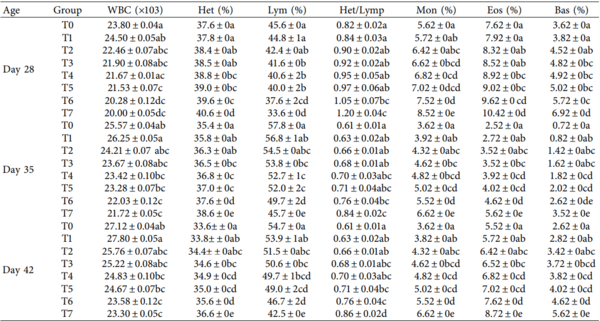

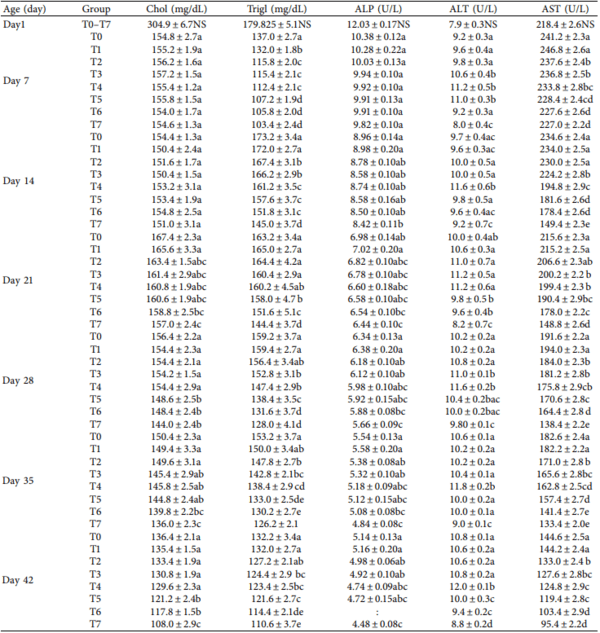
1] M. Muthusamy and V. Sankar, “Phytogenic compounds used as a feed additive in poultry production,” International Journal of Science, Environment and Technology, vol. 4, no. 1, pp. 167–171, 2015.
[2] M. B. Yitbarek, “Phytogenics as feed additives in poultry production: a review,” International Journal of Extensive Research, vol. 3, pp. 49–60, 2015.
[3] A. A. Saleh, T. A. Ebeid, and A. M. Abudabos, “Effect of dietary phytogenics (herbal mixture) supplementation on growth performance, nutrient utilization, antioxidative properties, and immune response in broilers,” Environmental Science and Pollution Research, vol. 25, no. 15, pp. 14606– 14613, 2018.
[4] S. H. Qamar, A. U. Haq, N. Asghar, S. U. Rehman, P. Akhtar, and G. Abbas, “Effect of herbal medicine supplementations (Arsilvon super, Bedgen40 and hepa-cure herbal medicines) on growth performance, immunity and haematological profile in broilers,” Advances in Zoology and Botany, vol. 3, no. 2, pp. 17–23, 2015.
[5] T. Azeem, Z. Ur-Rehman, S. Umar, M. Asif, M. Arif, and A. Rahman, “Effect of Nigella Sativa on poultry health and production: a review,” Science Letters, vol. 2, no. 2, pp. 76–82, 2014.
[6] S. Nazir, S. Arif Zaidi, and Z. Zaidi, “Kalonji seeds (Nigella sativa) in strengthening the immune system,” Madridge Journal of Case Reports and Studies, vol. 2, no. 1, pp. 55-56, 2018.
[7] M. T. Salman, R. A. Khan, and I. Shukla, “Antibacterial Activity of Nigella Sativa Linn. seeds against multiple antibiotics resistant clinical strains of Staphylococcus aureus,” International Archives of BioMedical and Clinical Research, vol. 2, no. 3, pp. 96–99, 2016.
[8] G. Z. A. Soliman, A. M. Hashem, and M. Arafa, “Protective effect of Curcuma longa or Nigella sativa on AflatoxinB1 induced hepato-toxicity in rats in relation to food safety on public health,” Medical Journal of Cairo University, vol. 80, no. 2, pp. 191–203, 2012.
[9] H. Pourbakhsh, E. Taghiabadi, K. Abnous, A. T. Hariri, S. M. Hosseini, and H. Hosseinzadeh, “Effect of Nigella sativa fixed oil on ethanol toxicity in rats,” Iranian Journal of Basic Medical Sciences, vol. 17, no. 12, pp. 1020–1031, 2014.
[10] R. D. M. El-Shoukary, M. H. A. Darwish, and M. A. M. AbdelRahman, “Behavioral, performance, carcass traits and hormonal changes of heat stressed broilers feeding black and coriander seeds,” Journal of Advanced Veterinary Research, vol. 4, no. 1, pp. 93–101, 2014.
[11] M. R. Haj-Syed Hadi, M. T. Darzi, and G.-H. Riazi, “Black cumin (Nigella sativa L.) yield affected by irrigation and plant growth promoting bacteria,” Journal of Medicinal Plants and By-Products, vol. 2, pp. 125–133, 2016.
[12] Y. Niu, L. Zhou, L. Meng et al., “Recent progress on chemical constituents and pharmacological effects of the genus Nigella,” Evidence-Based Complementary and Alternative Medicine, vol. 2020, Article ID 6756835, 15 pages, 2020.
[13] A. Ahmad, A. Husain, M. Mujeeb et al., “A review on therapeutic potential of Nigella sativa: a miracle herb,” Asian Pacific Journal of Tropical Biomedicine, vol. 3, no. 5, pp. 337–352, 2013.
[14] H. Mollazadeh and H. Hosseinzadeh, “'e protective effect of Nigella sativa against liver injury: a review,” Iranian Journal of Basic Medical Sciences, vol. 17, pp. 958–966, 2014.
[15] I. Jehani and E. H. Abdel-Hakiem, “Quality improvement of damietta cheese using some spices extract,” Assiut Veterinary Medical Journal, vol. 61, no. 147, pp. 24–32, 2015.
[16] M. Ardiana, B. S. Pikir, A. Santoso, H. O. Hermawan, and M. J. Al-Farabi, “Effect of Nigella sativa supplementation on oxidative stress and antioxidant parameters: a Meta-Analysis of Randomized Controlled Trials,” >eScientificWorldJournalfic World Journal, vol. 2020, Article ID 2390706, 7 pages, 2020.
[17] F. Ahmad, F. A. Ahmad, S. A. Ashraf et al., “An updated knowledge of Black seed (Nigella sativa Linn): review of phytochemical constituents and pharmacological properties,” Journal of Herbal Medicine, vol. 25, Article ID 100404, 2021.
[18] M. N. Islam, K. S. Hossain, P. P. Sarker et al., “Revisiting pharmacological potentials of Nigella sativa seed: a promising option for COVID-19 prevention and cure,” Phytotherapy Research, vol. 35, no. 3, pp. 1329–1344, 2020.
[19] M. F.-E.-A. Kulyar, R. Li, K. Mehmood, M. Waqas, K. Li, and J. Li, “Potential influence of Nigella sativa (Black cumin) in reinforcing immune system: a hope to decelerate the COVID19 pandemic,” Phytomedicine, vol. 85, Article ID 153277, 2021.
[20] N. M. P. Maideen, “Prophetic medicine-Nigella Sativa (Black Cumin seeds) potential herb for COVID-19?” Journal of Pharmacopuncture, vol. 23, no. 2, pp. 62–70, 2020.
[21] A. Saleh, “Nigella seed oil as alternative to avilamycin antibiotic in broiler chicken diets,” South African Journal of Animal Science, vol. 44, no. 3, pp. 254–261, 2014.
[22] R. Aydin, M. Karaman, T. Cicek, and H. yardibi, “Black cumin (Nigella sativa L.) supplementation into the diet of the laying hen positively influences egg yield parameters, shell quality, and decreases egg cholesterol,” Poultry Science, vol. 87, no. 12, pp. 2590–2595, 2008.
[23] J. Boka, A. H. Mahdavi, A. H. Samie, and R. Jahanian, “Effect of different levels of black cumin (Nigella sativa L.) on performance, intestinal Escherichia coli colonization and jejunal morphology in laying hens,” Journal of Animal Physiology and Animal Nutrition, vol. 98, no. 2, pp. 373–383, 2014
[24] S. S. Miraghaee, B. Heidary, H. Almasi, A. Shabani, M. Elahi, and M. H. Modaber-Nia, “'e effects of Nigella sativa powder (black seed) and Echinacea purpurea (L.) Moench extract on performance, some blood biochemical and hematological parameters in broiler chickens,” African Journal of Biotechnology, vol. 10, no. 82, pp. 19249–19254, 2011
[25] A. Ragab, K. El-Reidy, and H. Gaafar, “Effect of diet supplemented with pumpkin (cucurbita moschata) and black seed (Nigella sativa) oils on performance of rabbits: 1- growth performance, blood hematology and carcass traits of growing rabbits,” Journal of Animal and Poultry Production, vol. 4, no. 7, pp. 381–393, 2013.
[26] O. A. A. Ali, N. Suthama, and L. D. Mahfud, “'e effect of feeding Black Cumin (Nigella sativa) and Vitamin C on blood lipid profiles and growth performance of broilers,” International Refereed Journal of Engineering and Science, vol. 3, no. 4, pp. 28–33, 2014.
[27] G. Elmowalid, A. M. Amar, and A. A. M. Ahmad, “Nigella sativa seed extract: 1. Enhancement of sheep macrophage immune functions in vitro,” Research in Veterinary Science, vol. 95, no. 2, pp. 437–443, 2013.
[28] S. B¨uy¨ukozt¨urk, A. Gelincik, F. ¨ Ozs¸eker et al., “ ¨ Nigella sativa (black seed) oil does not affect the T-helper 1 and T-helper 2 type cytokine production from splenic mononuclear cells in allergen sensitized mice,” Journal of Ethnopharmacology, vol. 100, no. 3, pp. 295–298, 2005.
[29] N. A. Al-Beitawi, S. S. El-Ghousein, and A. H. Nofal, “Replacing bacitracin methylene disalicylate by crushed Nigella sativa seeds in broiler rations and its effects on growth, blood constituents and immunity,” Livestock Science, vol. 125, no. 2-3, pp. 304–307, 2009.
[30] K. Dhama, S. K. Latheef, S. Mani et al., “Multiple beneficial applications and modes of action of herbs in poultry health and production-A review,” International Journal of Pharmacology, vol. 11, no. 3, pp. 152–176, 2015.
[31] A. R. Gado, H. F. Ellakany, A. R. Elbestawy et al., “Herbal medicine additives as powerful agents to control and prevent avian influenza virus in poultry-a review,” Annals of Animal Science, vol. 19, no. 4, pp. 905–935, 2019.
[32] I. M. Yimer, K. B. Tuem, A. karim, N. Ur-Rehman, and
F. Anwar, “Nigella sativa L. (black cumin): a promising natural remedy for wide range of illnesses,” Evidence-Based
Complementary and Alternative, vol. 2019, Article ID
1528635, 17 pages, 2019.
[33] M. N. Alloui, A. Agabou, and N. Alloui, “Application of herbs and phytogenic feed additives in poultry production-A Review,” Global Journal of Animal Scientific Research, vol. 2, no. 3, pp. 234–243, 2014.
[34] M. Saeed, A. Baloch, M. Wang et al., “Use of Cichorium
Intybus leaf extract as growth promoter, hepatoprotectant and immune modulent in broilers,” Journal of Animal Production
Advances, vol. 5, no. 1, pp. 585–591, 2015.
[35] C. Yang, M. A. Chowdhury, Y. Huo, and J. Gong, “Phytogenic compounds as alternatives to in-feed antibiotics: potentials and challenges in application,” Pathogens, vol. 4, no. 1, pp. 137–156, 2015.
[36] F. R. Durrani, “Effect of different levels of feed added black seed (Nigella sativa L.) on the performance of broiler chicks,”
Pakistan Journal of Biological Sciences, vol. 10, no. 22, pp. 4164–4167, 2007.
[37] R. S. Shewita and A. F. Taha, “Effect of dietary supplementation of different levels of black seed (Nigella sativa L.) on growth performance, hematological and carcass parameters of broiler chicks,” International Scholarly and Scientific Research
& Innovation, vol. 5, no. 5, pp. 1031–1037, 2011.
[38] H. A. Ghasemi, N. Kasani, and K. Taherpour, “Effects of black cumin seed (Nigella sativa L.), a probiotic, a prebiotic and a synbiotic on growth performance, immune response and blood characteristics of male broilers,” Livestock Science, vol. 164, pp. 128–134, 2014.
[39] M. M. Hossain, A. J. Howlader, M. N. Islam, and M. A. Beg,
“Evaluation of locally available herbs and spices on physical, biochemical and economical parameters on broiler production,” International Journal of Plant, Animal and Environmental Sciences, vol. 4, no. 1, pp. 317–322, 2014.
[40] K. Shirzadegan, P. Fallahpour, I. Nickkhah, and H. I. Taheri,
“Black Cumin (Nigella sativa) supplementation in the diet of broilers influences liver weight and its enzymes,” Iranian
Journal of Applied Animal Science, vol. 5, no. 1, pp. 173–178,
2015.
[41] P. K. Singh and A. Kumar, “Effect of dietary Black Cumin (Nigella sativa) on the growth performance, nutrient utilization, blood biochemical profile and carcass traits in broiler chickens,” Animal Nutrition and Feed Technology, vol. 18, no. 3, pp. 409–419, 2018.
[42] S. Aydogan, “'e effect of dietary garlic (allium sativum), black cumin (Nigella sativa) and their combination on performance, intestine morphometry, serum biochemistry and antioxidant status of broiler chickens,” Brazilian Journal of
Poultry Science, vol. 22, no. 4, 2020.
[43] P. J. Miller, C. L. Afonso, J. El Attrache et al., “Effects of
Newcastle disease virus vaccine antibodies on the shedding and transmission of challenge viruses,” Developmental &
Comparative Immunology, vol. 41, no. 4, pp. 505–513, 2013.
[44] P. J. Miller and G. Koch, “Newcastle disease,” in Diseases of
Poultry, S. E. Swayne, Ed., , John Wiley & Son, In, Ames, IW,
USA, 2013, https://onlinelibrary.wiley.com/doi/book/10.
1002/9781119371199, 14th edition.
[45] S. E. Collett and J. Smith, “Principles of disease prevention, diagnosis, and control,” in Diseases of Poultry, S. E. Swayne,
Ed., Wiley-Blackwell, Oxford, UK, 14th edition, 2020.
[46] T. W. Campbell, Avian Hematology and Cytology, Iowa State
University Press, Ames, IW, USA, 1992.
[47] S. Ali, M. Mukhtar, S. Manzoor et al., “Effect of garlic, black seed and turmeric on the growth of broiler chicken,” Pakistan
Journal of Nutrition, vol. 13, no. 4, pp. 204–210, 2014.
[48] F. K. Abdullah, A. Y. Al-Nasser, A. Al-Saffar, A. E. Omar, and
G. Ragheb, “Impact of dietary supplementation of different levels of black seeds (Nigella sativa L.) on production performance, mortality and immunity of broiler chickens,” International Journal of Poultry Science, vol. 18, no. 10, pp. 467–474, 2019.
[49] Office International Epizootic (OIE), “Newcastle disease,” in
Terrestrial Manual 2012OIE, Paris, France, 2012, https://www. oie.int/fileadmin/home/eng/animal_health_in_the_world/ docs/pdf/.
[50] S. R. Rehman, K. Muhammad, T. Yaqub, M. S. Khan,
K. Hanif, and R. Yasmeen, “Antimicrobial activity of mentofin and its effect on antibody response of broilers to Newcastle disease virus vaccine,” >e Journal of Animal & Plant Sciences, vol. 23, no. 4, pp. 1008–1011, 2013.
[51] S. H. Khan, M. A. Anjum, A. Parveen, T. Khawaja, and
N. M. Ashraf, “Effects of black cumin seed (Nigella sativa L.) on performance and immune system in newly evolved crossbred laying hens,” Veterinary Quarterly, vol. 33, no. 1, pp. 13–19, 2013.
[52] S. Nazrul Islam, P. Begum, T. Ahsan, S. Huque, and M. Ahsan,
“Immunosuppressive and cytotoxic properties ofNigella sativa,” Phytotherapy Research, vol. 18, no. 5, pp. 395–398, 2004.
[53] N. A. Al-Beitawi, S. S. El-Ghousein, S. Safaa, and
M. Z. Athamneh, “Effect of adding crushed Pimpinella anisum, Nigella sativa seeds and >ymus vulgaris mixture to antibiotics-free rations of vaccinated and non-vaccinated male broilers on growth performance, antibody titer and haematological profile,” Italian Journal of Animal Science, vol. 9, no. 2, p. e43, 2010.
[54] M. L. Salem, “Immunomodulatory and therapeutic properties of the Nigella sativa L. seed,” International Immunopharmacology, vol. 5, no. 13-14, pp. 1749–1770, 2005.
[55] W.-T. Ma, F. Gao, K. Gu, and D.-K. Chen, “'e role of monocytes and macrophages in autoimmune diseases: a comprehensive review,” Frontiers in Immunology, vol. 10, p. 1140, 2019.
[56] S. Simaraks, O. Chinrasri, and W. Aengwanich, “Hematological, electrolyte and serum biochemical values of the 'ai indigenous chickens (Gallus domesticus) in northeastern,
'ailand,” Songklanakarin Journal of Science and Technology, vol. 26, no. 3, pp. 425–430, 2004.
[57] Z. Nasir, “Comparison of effects of Echinacea purpurea juices and Nigella sativa seeds on performance, some blood parameters, carcass and meat quality of broilers,” Doctoral dissertation, University of Hohenheim, Stuttgart, Germany,
2009.
[58] O. Alabi, F. Aderemi, and O. Adeniji, “Effect of alternative housing Systems on blood profile of egg-type chickens in humid tropics,” American Journal of Experimental Agriculture, vol. 7, no. 4, pp. 197–204, 2015.
[59] K. Al-Kubaisy and M. Al-Noaemi, “A protective role of
Nigella sativa oil against the harmful effect of CCl4 on the liver cells,” >e Internet Journal of Nutrition and Wellness, vol. 3, no. 1, 2006.
[60] A. Mohtashami, “Effects of bread with Nigella sativa on blood glucose, blood pressure and anthropometric indices in patients with metabolic syndrome,” Clinical Nutrition Research, vol. 8, no. 2, pp. 138–147, 2019.
[61] M. A. Dollah, S. Parhizkar, L. A. Lattif, A. S. ardekani, and
D. E. Zulaikha, “Natural approach for Calcium regulating
14 Evidence-Based Complementary and Alternative Medicine hormone maintenance: beneficial effects of Black seed,” Asian
Journal of Biomedical and Pharmaceutical Sciences, vol. 2, no. 15, pp. 32–37, 2012.
[62] P. R. Saunders, “Nigella sativa dissolves small renal liths,”
Natural Medicine Journal, vol. 11, no. 12, 2019.
[63] U. Polat, D. Yesilbag, and M. Eren, “Serum biochemical profile of broiler chickens fed diets containing rosemary and rosemary volatile oil,” Journal of Biological & Environmental
Sciences, vol. 5, no. 13, pp. 23–30, 2011.
[64] F. Yildiz, S. Coban, A. Terzi et al., “Nigella sativa relieves the deleterious effects of ischemia reperfusion injury on liver,”
World Journal of Gastroenterology, vol. 14, no. 33, pp. 5204–
5209, 2008.









.jpg&w=3840&q=75)